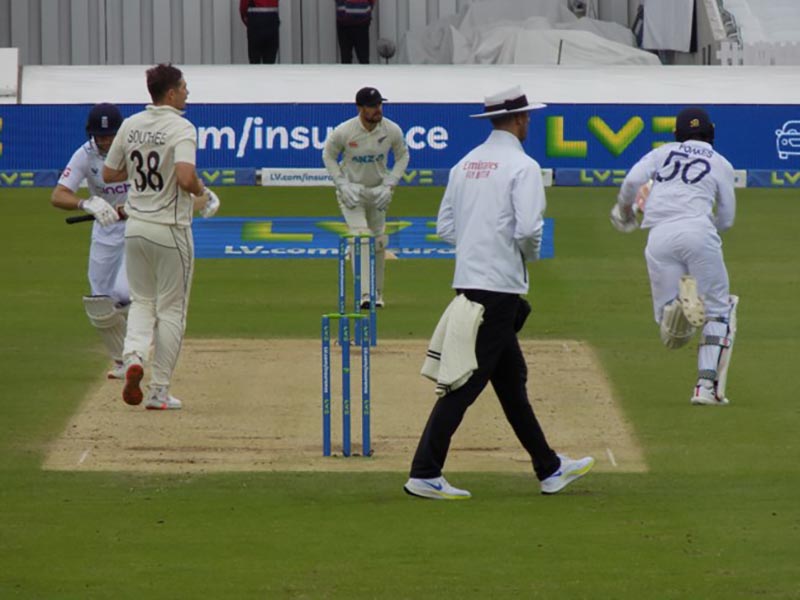|
|
| ENGLAND VS. NEW ZEALAND FIRST TEST HIGHLIGHTS, LORDíS |
| |
|
|
- The Test saw the third occasion of the first four players being dismissed for a combined total of seven runs (or fewer). The other occasions were for India against England at Manchester in 2014 (Test 2134), and West Indies against New Zealand at Bridgetown in 1971-72 (Test 695). This figure is distinct from the first four wickets falling for seven or fewer runs, and applies to the first innings of a Test.
- In losing their seventh wicket at 45, New Zealandís start was the joint-eleventh worst by any team in the first innings of a Test. It is the second-worst start at Lordís. Both figures are based on runs scored at the loss of the seventh wicket in the first innings of a Test.
- Matthew Pottsís match figures of 7 for 68 are the eighth best by a player making his Test debut at Lordís. Bob Massieís 16 for 137 in 1972 Ė fifty years ago this month Ė are the best.
- Colin de Grandhomme became the first New Zealand player to be run out first ball and the second player at Lordís, after Srinivas Venkataraghavan in 1979. This excludes those players run out without facing a ball.
- Jonny Bairstow became the first England player to be dismissed bowled in both innings of a Test on six occasions. Johnny Briggs, Les Ames, Colin Cowdrey, Ted Dexter and Alec Stewart suffered similarly on five occasions.
- Bairstow has recorded the feat on four occasions at Lordís. There have been no other instances of a player being dismissed bowled twice in a match more than once.
- For the third occasion at Lordís, both first team innings took exactly the same amount of time. The other occasions were both between England and India, in 1959 and 1971.
- Joe Root became the fourteenth player, and second from England after Sir Alastair Cook, to score 10,000 Test runs.
- Rootís performance is the shortest in days (3462), just ahead of Cook (3505).
- Root became the third player after Rahul Dravid and Steve Waugh to achieve the feat whilst making a century. Root, though, is the first player to reach the century and the landmark from the same ball.
- Rootís second innings, unbeaten 115 is the highest score for an England-winning side in the fourth innings of a Lordís Test. The previous highest was Nasser Hussainís unbeaten 103, also against New Zealand, in 2004.
- The unbeaten partnership of 120 between Root and Ben Foakes is the highest for the sixth wicket in the fourth innings of a Test in a winning side at Lordís. The previous highest was 51 between Allan Border and Wayne Phillips for Australia in 1985.
- The 195-run partnership between Daryl Mitchell and Tom Blundell is the highest for the fifth wicket for New Zealand against England in England, surpassing the 180 in 1994, also at Lordís, by Martin Crowe and Shane Thomson.
- The Mitchell and Blundell partnership scored 68.42% of New Zealandís second innings total, a record for a completed innings for them against England. Against all countries, it is the second highest behind only the 91-run, opening partnership at Auckland in 2000-01 against Pakistan which ultimately realised 69.47% of the runs.
- Blundellís 96 was the fifth occasion where a non-England wicket-keeper has fallen in the 90s at Lordís joining his compatriot (and now England coach), Brendon McCullum (twice), Adam Gilchrist and South Africaís Jock Cameron. The last non-England wicket-keeper to safely survive the 90s was Sri Lankaís Amal Silva in 1984.
- Englandís first innings 141 is their lowest, completed total at Lordís after an opening stand of 50 or more. This beat their previous lowest of 151 against West Indies in 1950. The lowest score in the same circumstances by any team is Australiaís 132 in 1890.
- Stuart Broad finished the Test with 99 wickets at Lordís. Only James Anderson, who finished the same Test with 116, lies ahead of Broad.

My photo shows Joe Root setting off for the runs which saw him score his 26th Test century and 10,000 runs.
|
|
|
|